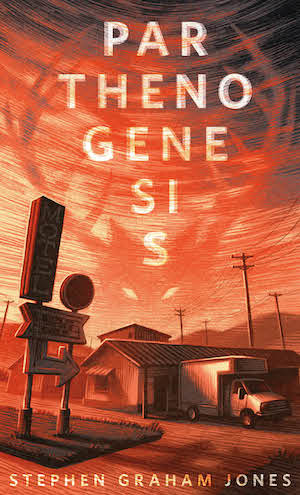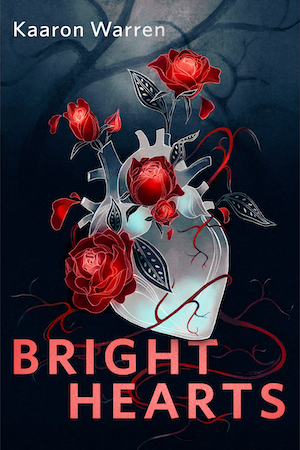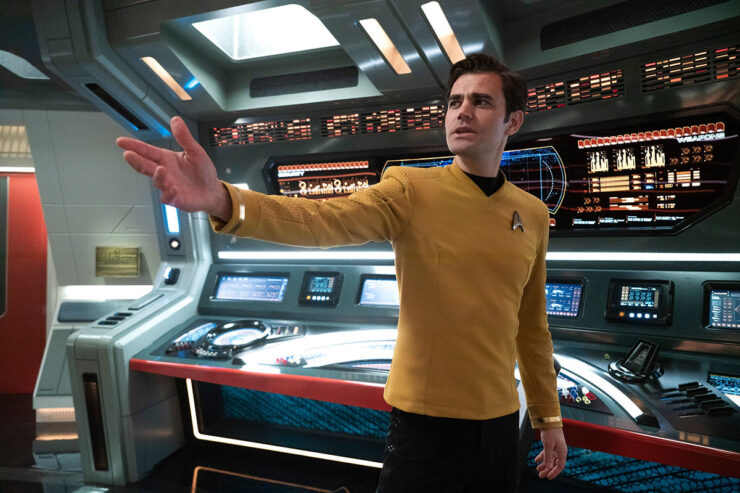Viewers of Strange New Worlds are gonna get whiplash. Seriously, we had “Those Old Scientists,” which was a hilarious Lower Decks crossover, and then we had “Under the Cloak of War,” which is one of the darkest, nastiest Trek episodes in the franchise’s five-decade-plus history.
And now we get the musical episode. But what’s fascinating (sorry) is that—like “Those Old Scientists”—this isn’t just a gag concept. Important character stuff happens amidst the singing and dancing.
There is a long history of TV shows deciding to do a musical episode. Sometimes it’s because the creator/executive producer grew up in show business and thought it would be cool (Buffy the Vampire Slayer’s “Once More, With Feeling”). Sometimes it’s because the show has a history of doing crazy-ass stuff, and this is in line with that (Xena’s “The Bitter Suite”). And sometimes it’s because the vast majority of your acting ensemble has singing chops and you want to take advantage (The Flash’s “Duet”).
Music has also been a part of Trek throughout its history. One of the most powerful scenes on TNG was the concert in “Sarek,” and the character of Data in particular explored the human condition through playing music. DS9 had a holographic lounge singer as a recurring regular in its latter seasons, with music playing a particularly strong role in “His Way,” “The Siege of AR-558,” “It’s Only a Paper Moon,” “Badda-Bing, Badda-Bang,” and “What You Leave Behind.” Voyager took advantage of the singing prowess of Tim Russ (“Innocence”) and Robert Picardo (“Virtuoso”). And, going back to the original series, we have the space hippies’ music in “The Way to Eden” and just in general the character of Uhura. The character’s predilection for music, taking advantage of Nichelle Nichols’ background as a singer and musical theatre star, was a part of many episodes, such as “Charlie X,” “The Conscience of the King,” and “The Changeling.”
Like Nichols, Celia Rose Gooding came to the role of Uhura from a background in singing and musical theatre, having won a Grammy and been nominated for a Tony prior to joining the cast of SNW. And while she is very obviously the most talented singer in the ensemble, she’s not the only good one…

Part of me was tempted to do this entire review without mentioning the plot because it’s not really that important. But that’s not fair, so let’s get it out of the way: there’s a subspace fold, and Spock and Uhura are trying to see if they can use it to enhance communications. All attempts to do so have failed, and Pelia—upon hearing Uhura hum while working, as she does—suggests sending music into the fold rather than words. Doing so activates an improbability field that takes the music Uhura put in—“Anything Goes” from the musical of the same name—and has an effect on everything around it. Suddenly, people on the Enterprise break out in song when they’re feeling particularly emotional.
The effect spreads, and soon half the quadrant is breaking into song, including the Klingons. One of the best moments in this episode full of them is a Klingon captain and his bridge crew breaking into what appears to be a hip-hop number. Points for both defying expectations (I, at least, was expecting Klingon opera) and also for casting Bruce Horak as the Klingon captain. The erstwhile Hemmer can carry a tune and bust a move…
Jim Kirk is on board, too, and he and Number One have a delightful duet on the subject of being a good first officer, complete with ballroom dancing bits. Kirk is there to shadow Number One prior to taking on his new role as the Farragut’s first officer. Paul Wesley has a lovely voice, and we now have confirmation that two out of three Jim Kirks can sing, as Chris Pine can also croon beautifully. (If you’re wondering about the third, check out this. Or this. Or this. Or, better yet, don’t…)
Buy the Book
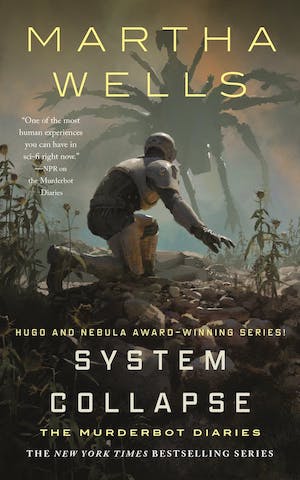

System Collapse
There’s a lot that’s impressive about this episode, but the thing that I loved most is that, like the Buffy musical episode, and unlike the Xena and Flash ones, this is still an important episode that has serious character ramifications. (There’s also a reference to the Buffy episode, as La’an, M’Benga, and Spock discuss the possibility of them all being changed into bunnies. Even if the rest of the episode was terrible, it’d be worth it to hear Ethan Peck calmly intone, “I doubt we will be bunnies.”)
One of those ramifications involves Kirk and La’an, as the latter decides to go ahead and tell Kirk what happened in “Tomorrow and Tomorrow and Tomorrow.” A big reason why is that people are revealing their innermost feelings in song whether they want to or not. As La’an herself says: “I need to say this before it comes out in a seventeenth-century sea shanty.”
Kirk’s reply is at once unexpected and spot-on: he enjoys La’an’s company, but he’s kind of seeing someone, and it’s in an awkward place because she’s pregnant and he’s on the Farragut and it’s a big ol’ mess. And then one does the math and realizes that, yes, it tracks that Kirk would be in the midst of his relationship with Carol Marcus right about now and she’d be pregnant with their son, David. And Spock knew about Carol and David in The Wrath of Khan, so having this shortly after Kirk and Spock first met is perfect.
It’s a beautiful moment, especially since it catches La’an off-guard—and the viewer as well, since we’re all trained to see Kirk as the guy who has multiple successes with the opposite sex.
However, it all works out nicely, since La’an bares her soul to Kirk and the universe doesn’t come to a halt, and she admits at the end to Number One that she might be emotionally open again some time. (It’s also great to see the Number One-La’an mentor/student relationship again, as that’s a nifty dynamic we’ve seen too little of…)
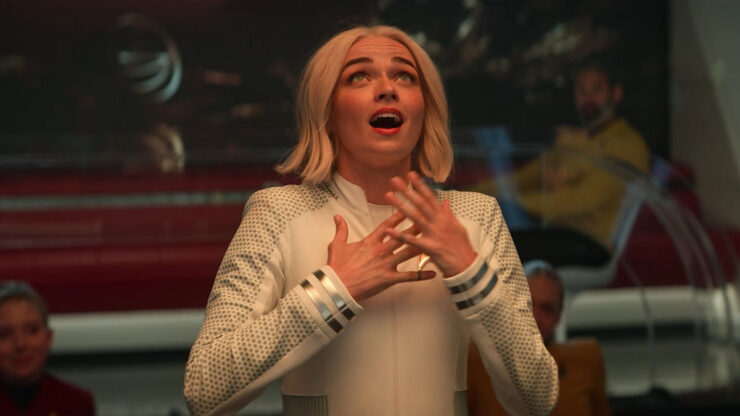
The biggest character moments here, though, belong to Spock and Chapel. One of the most fabulous things SNW has accomplished is to completely recontextualize the Spock-Chapel pairing in the original series. The realities of 1960s television are such that we only caught glimpses when it was important to the plot (“The Naked Time,” “Amok Time,” “Plato’s Stepchildren,” “Return to Tomorrow”), as character development wasn’t really a thing. The common interpretation of Chapel’s obvious interest in Spock and Spock’s never really reciprocating (aside from some sweet moments in “Amok Time,” anyhow) was Chapel having an unrequited crush on Spock and Spock being a stoic Vulcan who can’t return the feelings.
But having them be exes works just as well in the context of the minimal information we got from 1966-1969, and makes Chapel significantly less pathetic and Spock significantly less mean.
And the breaking point is here. Chapel has applied for another fellowship, this one with Dr. Roger Korby (who we know she will later become engaged to, per the original series’ “What Are Little Girls Made Of?”). Spock is hurt that she doesn’t tell him that she got the fellowship, but their relationship has been rocky since “Under the Cloak of War” when Spock found himself unable to comfort the PTSD-wracked Chapel. Which, by the by, is another reason why the heavy episode needed to be inserted there, as it was another wedge to drive between Spock and Chapel (as well as the one Boimler hammered in when talking to Chapel in the turbolift in “Those Old Scientists”).
It also gives us the big Act 1 finale, and that’s the other wonderful thing about this episode: it follows the structure of musical theatre beautifully. (Uhura herself points this out.) We have the jaunty opening number, which has the added amusement of everyone realizing they’re singing and having no idea why. Anson Mount in particular has a magnificent WTF face throughout—well, most of episode, really. It’s hilarious.
Then we have the upbeat character bit with Number One and Kirk, the revelatory intense song from La’an, and then we get Chapel celebrating the fellowship. Spock comes to the bar to ask why she didn’t tell him. Chapel’s response is a glorious dance number that everyone in the bar (except Spock) participates in.
That’s followed by an introspective ballad by Spock, which is a masterpiece by Peck. Besides the fact that he has a great singing voice, he also moves around engineering, maintaining a placid facial expression and walking and moving just like Leonard Nimoy did. All while singing forlornly about the pitfalls of emotionalism. It’s a bravura performance.
And then we have the grand finale. Off-camera, April has told Number One (“in a surprisingly beautiful baritone”) that they need to fix this, and Uhura and Spock have figured out a way from their examinations of the subspace fold. And there’s a ticking clock, because the Klingons are going to blow the thing up (between hip-hop songs, anyhow). This is a problem, as Spock has determined that an attempt to blow up the fold will result in a catastrophic explosion that will wipe out large chunks of the Federation and the Empire.
Her solution: a grand finale. A musical number that the entire crew sings, which is inspired by Uhura herself who, as communications officer, feels like she knows everyone on board, and she has seen what a great crew they can be. The closing number does the technobabble thing it needs to do and the fold collapses and everyone lives happily ever after.
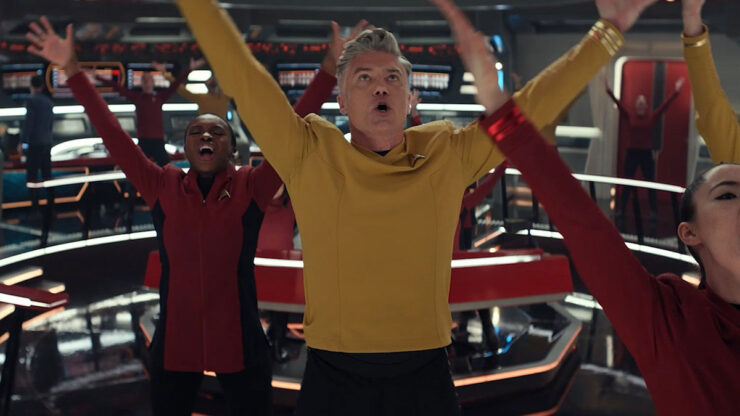
One of the running themes since the second episode of this series has been Uhura trying to find her way. She joined Starfleet mostly for lack of anything better to do after her parents and brother died. In this episode, she truly finds where she belongs: as the hub at the center of this little city in space.
We also see the developing friendship between her and Spock. Here’s another relationship that we saw hints of on the original series (“Charlie X,” “Who Mourns for Adonais?” “Is There in Truth No Beauty?” among others). The Bad Robot films chose to interpret that as a romantic relationship, but it’s just as supportable that it’s a deep friendship, and the seeds of it are sown especially in this episode where they work so closely together and also when Spock confides in her about his feelings for Chapel.
On top of that, we’ve got development of the Pike-Batel relationship, as the enforced singing gets Pike to admit that the vacation Batel has planned for them is of absolutely no interest to him. (She doesn’t need to be forced to sing to tell him that his alternative of camping is of even less interest to her.)
Indeed, the difficulties of relationships are all over this episode, from Kirk hinting at the problems he and Marcus are having, to Pike and Batel, to Spock and Chapel, to La’an and Kirk.
The singing is sensibly divvied up at least in part based on talent. The best voice in the cast is Gooding, and she gets the most vocal time, and also the most powerful song of the bunch, her revelatory solo in engineering. Peck and Christina Chong are next best, and they get numbers that show off their talents—Peck’s expressive voice and Chong’s powerful one. Wesley, Jess Bush, Melissa Navia, Melanie Scrofano, and Rebecca Romijn are all good singers, and they get their moments in the sun. Mount and Babs Olusanmokun get very few solo bits, while Carol Kane only sings as part of the chorus.
The most important thing here is that the episode is fun. In the grand finale, Uhura is leading the singing, and Gooding is bopping back and forth with a big smile on her face, and it’s infectious. I was bopping right along with her.
And with all that, it’s still a strong and powerful episode of SNW. Just an absolute masterpiece. Even if you do get whiplash from having this right after the Klingon War PTSD episode…
Keith R.A. DeCandido has starred in productions of The Mikado, HMS Pinafore, The Pirates of Penzance, The Gondoliers, The Music Man, Oklahoma!, Doctor Doolittle, West Side Story, Damn Yankees, and You’re a Good Man, Charlie Brown. However, they were all when he was between the ages of six and sixteen. Still, he performed “Model of a Modern Major General” in Penzance at the age of eight, which he considers one of his prouder accomplishments. He also played Snoopy in …Charlie Brown, which has surprised absolutely nobody who knows him.


